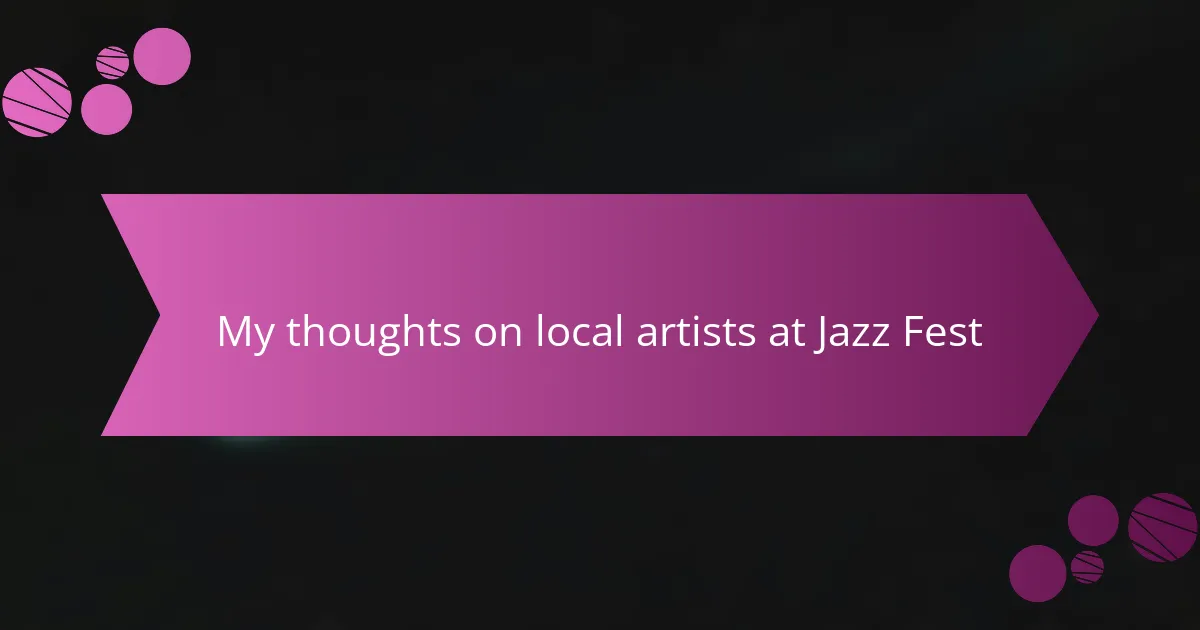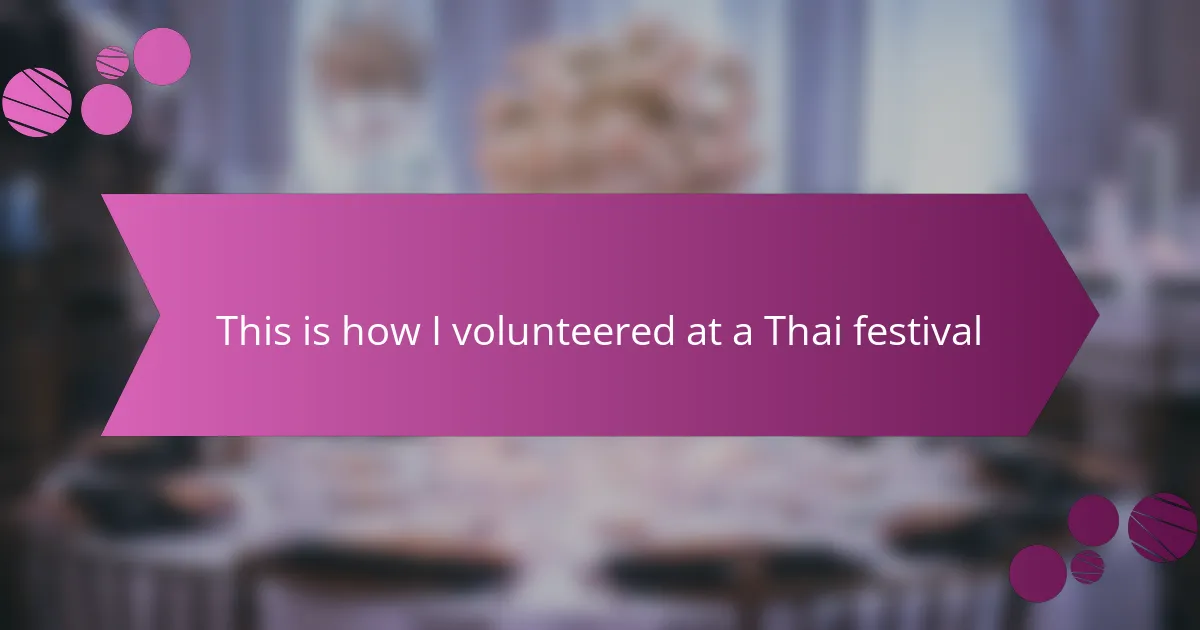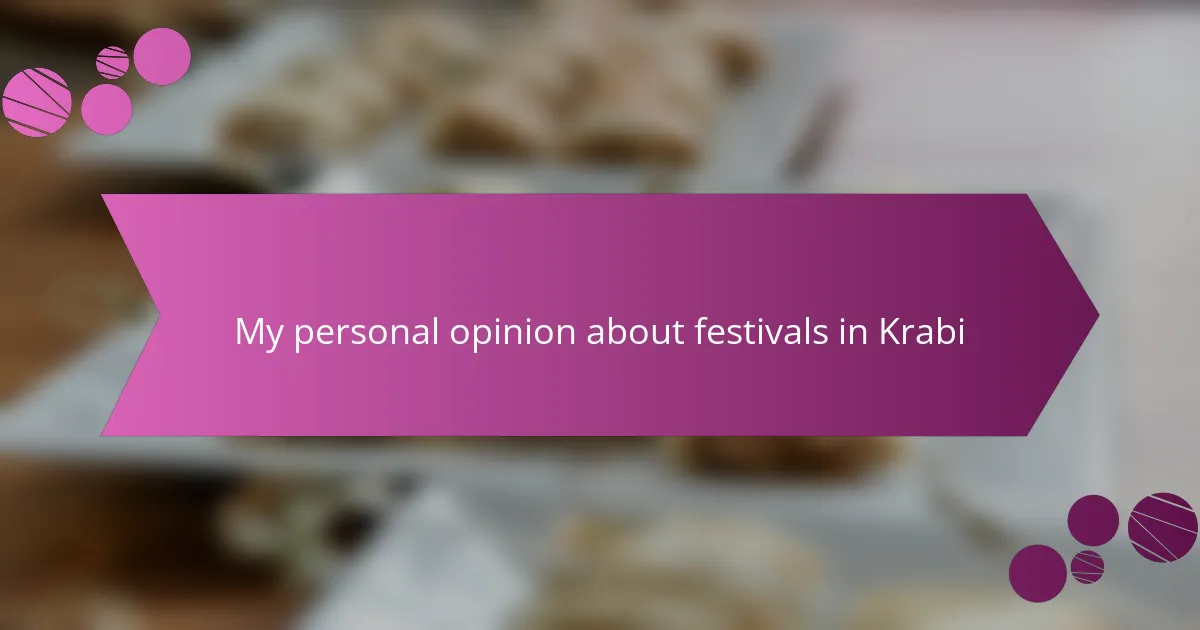Key takeaways
- Thai music festivals showcase a blend of diverse genres, from traditional to contemporary, fostering community connections and cultural exchange.
- Local artists are essential for highlighting cultural heritage, providing emotional performances that resonate deeply with audiences.
- Thai jazz uniquely combines traditional melodies and instruments with improvisational jazz elements, creating a vibrant musical experience.
- Memorable performances often stem from local talent, embodying the spirit of Thailand and forming emotional connections with attendees.
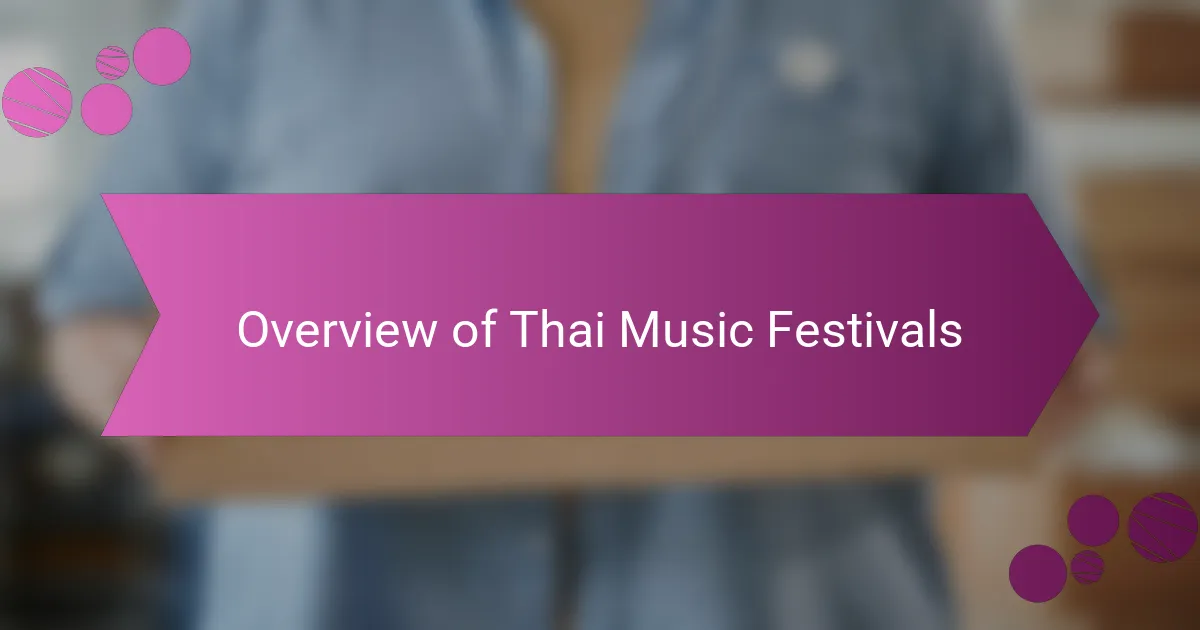
Overview of Thai Music Festivals
Thai music festivals are vibrant celebrations of culture, showcasing the rich diversity of Thailand’s musical landscape. Having attended several over the years, I’ve always been struck by how they bring different genres together, from traditional forms like Khon and Lakhon to contemporary styles. It’s an immersive experience that transcends mere entertainment; it’s a joyful tapestry of sounds that connects people through shared emotions and experiences.
These festivals often feature a lineup of talented local artists who play a crucial role in the overall atmosphere. Their performances not only highlight their unique talents but also evoke a deep sense of pride in our cultural heritage. Here’s what I find captivating about Thai music festivals:
- Diverse Genres: From traditional Thai music to modern pop and jazz, there is something for everyone.
- Community Engagement: Artists often collaborate with local musicians, reinforcing community ties.
- Cultural Exchange: Festivals attract international attention, fostering a blend of different musical influences.
- Emotional Connection: The live performances invoke powerful emotions, creating lasting memories for attendees.
- Emerging Talent: Many local artists get their start at these festivals, providing them a platform to shine.
I remember the first time I saw a local band play at one of these festivals; the energy was electric, and I felt an emotional connection that lingered long after the show.
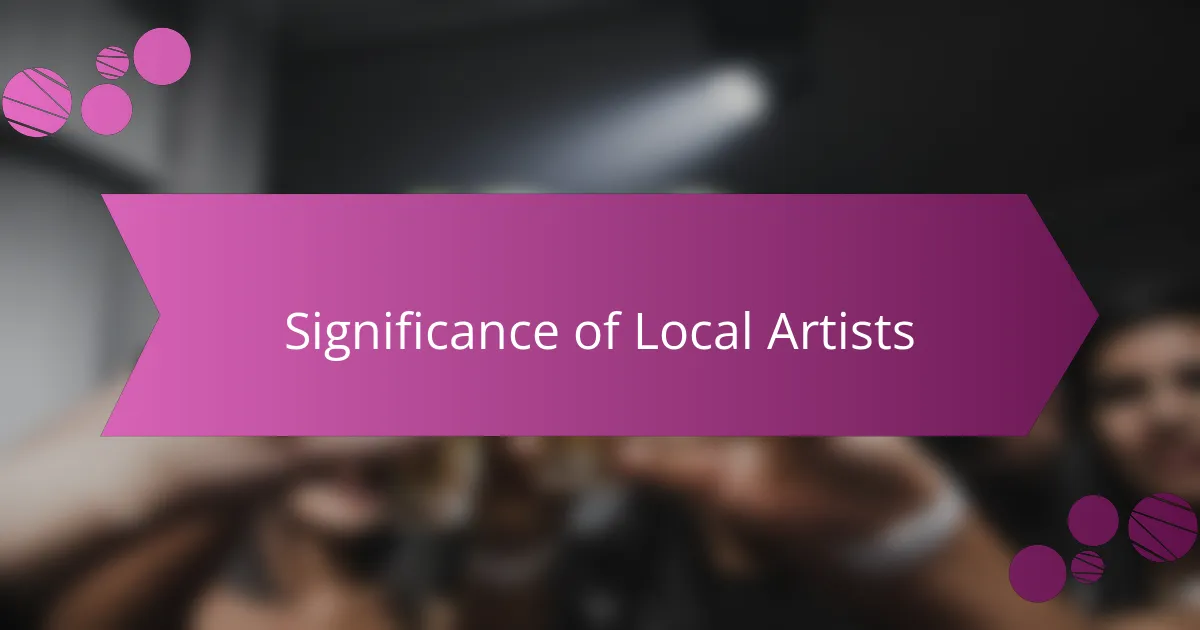
Significance of Local Artists
Local artists play a vital role at Jazz Fest, bringing unique cultural flavors and authentic expressions to the stage. I’ve often found that their performances resonate deeply with attendees, creating a sense of community that larger, more famous acts sometimes overlook. For me, the excitement of discovering a new artist who captures the spirit of our local scene is one of the festival’s highlights.
Supporting local talent is essential, not just for their growth but also for the rich tapestry of our music culture. It’s heartwarming to see individuals who have poured their soul into their craft receive recognition on such a significant platform. Here are some reasons why local artists matter at Jazz Fest:
- They showcase local culture and traditions, offering a deeper connection to the community.
- Their performances often feature original compositions, highlighting personal storytelling.
- They provide opportunities for collaboration, fostering creativity and innovation among musicians.
- Fans can engage more closely with them, leading to meaningful interactions after performances.
- Supporting them helps sustain and nurture the local music scene, ensuring its vibrancy for future generations.
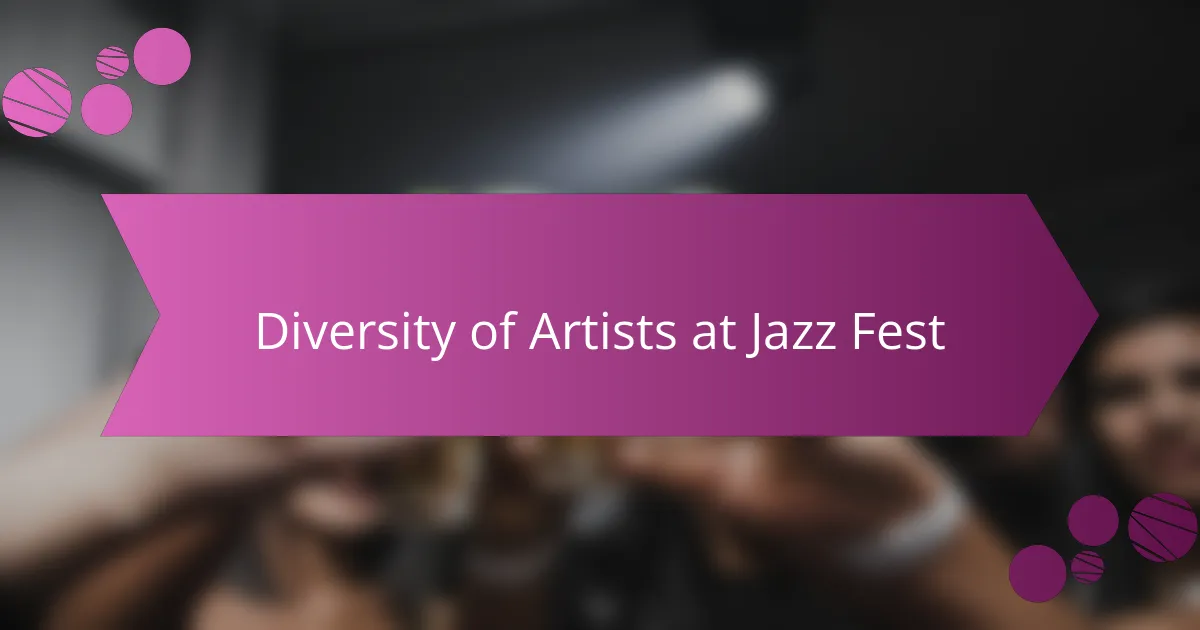
Diversity of Artists at Jazz Fest
The diversity of artists at Jazz Fest is one of its most captivating features. I remember attending a particular festival where I was blown away by the fusion of global music styles, from traditional jazz and blues to the vibrant rhythms of Latin and African influences. Experiencing musicians from different backgrounds come together on one stage made me realize just how interconnected our musical landscapes truly are.
The blend of genres and cultures creates a unique atmosphere that is both enriching and exciting. It’s not just about the music; it’s about the stories and emotions that each artist brings to their performance. Here are a few examples that highlight this wonderful diversity:
- Local bands that blend jazz with traditional Thai instruments, offering a fresh perspective on local music.
- International artists who introduce their native genres, creating unique collaborations with local musicians.
- Emerging talents representing various ethnic backgrounds, showcasing the myriad of influences that shape the jazz scene today.
- Performances that highlight different instruments, from the saxophone and trumpet to the khene and gamelan, making every act a new experience.
This variety not only highlights the rich tapestry of musical tradition but also reflects the community’s spirit, celebrating both authenticity and creativity.

Characteristics of Thai Jazz Music
Thai jazz music is truly unique. It blends traditional Thai melodies with the improvisation and rhythm of jazz, creating a sound that is both familiar and fresh. When I first heard local artists interpret classic Thai songs through jazz at a festival, it felt like I was reconnecting with my roots in a whole new way.
There’s a certain vibrancy in the way Thai jazz musicians incorporate instruments like the khim or the saxophone. The fusion not only showcases their technical prowess but also breathes new life into genres that might feel disparate on their own. I remember attending a performance where the artists seamlessly transitioned from a traditional Thai tune into a swinging jazz beat; it was exhilarating and captivating.
This blend of styles truly reflects the spirit of Thailand, where cultural diversity thrives. It’s like listening to a dialogue between the past and the present, allowing both the performer and the audience to connect on a deeper level.
| Characteristic | Description |
|---|---|
| Instrumentation | Incorporates traditional instruments like khim and ranat with Western jazz instruments |
| Improvisation | Features spontaneous musical creation, a hallmark of jazz, mixed with Thai themes |
| Melody and Harmony | Blends traditional Thai melodies with jazz harmonies for a unique sound |

My Favorite Local Artists
One of my favorite local artists is a jazz fusion band called “Siam Swing.” Their ability to weave traditional Thai melodies into contemporary jazz is simply mesmerizing. I recall being at their set last year when they played a breathtaking version of a classic Thai love song, layered with improvisational jazz solos. It felt like a beautiful conversation between cultures, leaving me with a warm sense of pride for our musical heritage.
Another standout group is “Bangkok Blue,” known for their dynamic performances that blend upbeat rhythms with heartfelt lyrics. I remember watching them take the stage one evening, the crowd buzzing in anticipation. As they dove into a song that spoke about life in the city, I was struck by how their music captured the essence of Thai urban life, resonating deeply with everyone in attendance.
Then there’s solo artist “Nai,” whose soulful saxophone skills can evoke emotions that run deep. During one of her performances, I was completely enchanted as she played a piece that told a story of hope and resilience. It’s amazing how one person with a single instrument can express such a wide range of feelings, drawing everyone into that intimate moment. Each note felt as if it embodied the spirit of our people, creating connections that last long after the music fades.

Memorable Performances at Jazz Fest
The performances that resonate the most with me at Jazz Fest often come from local artists who pour their heart and soul into each note. I remember standing in the crowd, captivated by a band called “Thai Groove,” as they seamlessly transformed a traditional Thai lullaby into an upbeat jazz piece. Was it the infectious rhythm or the glimmer of talent on stage? Perhaps it was both, sparking a joy that left many, including myself, swaying and smiling long after the final chord.
Another unforgettable moment I treasure was during a late-night jam session featuring a collection of local talents. The way they collaborated—sharing stories through music—felt electric. I witnessed an intimate exchange between musicians that translated into an uplifting experience for everyone present. Do you remember the last time you felt such connection through art? For me, it was that evening, where every clap and cheer from the audience echoed the joy of shared cultural pride.
Then there was that surprise performance by a young saxophonist named “Pattaya.” When she took the stage, the air shifted. Her soulful sound had a way of wrapping around you like a warm hug. I can still recall the moment she played a spontaneous solo that brought tears to my eyes. It made me realize how powerful a single instrument can be in storytelling. During that fleeting moment, it felt as if she was speaking directly to each listener, creating bonds through the universal language of music.
